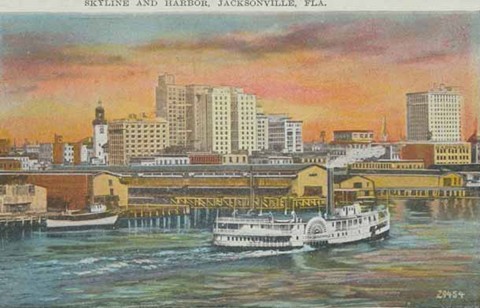
I’ve recently been reading up on the history of the Blackstone Rangers, the gang whose criminal entanglements contributed greatly to the post-1965 increase in Chicago’s homicide rate. In the course of my research, I started wondering about how the Rangers’ impact on the Second City compared to that of Al Capone’s organization. I had long assumed that Prohibition had caused a brief yet astronomical uptick in Chicago’s homicide rate, but it turns out that I was a bit mistaken—though death-by-violence was more common during Prohibition, the increase was nothing compared to what happened throughout the 1960s and ’70s.
For all its notoriety during the 1920s, in fact, Chicago wasn’t even one of the dozen most murderous American cities during the heyday of Capone. In those years, the murder capital of America was a place I would never have expected. A 1926 New York Times broke the bad news to denizens of northeast Florida:
“Our murder record for 1925 is the worst we have thus far experienced,” says Frederick L. Hoffman, consulting statistician of the Prudential Life Insurance Company of America, in an article in the current issue of The Spectator, an insurance journal.
“Preliminary statistic for seventy-seven American cities,” he goes on, “indicate an increase in the murder death rate from 10.8 per 100,000 in 1924 to 11.1 per 100,000 in 1925…
Jacksonville, Florida, had the highest homicide rate in 1925, Mr. Hoffman says. The rate was 72.3 per 100,000, as compared to 58.8 in 1924.
In other words, Jacksonville’s 1925 homicide rate was more than double what Chicago’s was at its violent peak. And things got even worse the following year.
Try as I might, I couldn’t find a good explainer on why Jacksonville was so lethal in the 1920s. But there are some data points worth considering, starting with the fact that the city was a major point of entry for Caribbean rum smugglers, many of whom bribed local authorities to look the other way as they went about their business. Perhaps just as importantly, the city had a terrible track record of tackling homicide cases involving black victims, particularly when a white perpetrator was the main suspect; it wasn’t until 1926 that the local courts convicted a white resident for the murder of a black man. (In general, Jacksonville has what might be politely termed a complicated racial history.)
It’s also worth noting that of the 15 American cities with homicide rates above 20 per 100,000 in 1927, 11 were located in the South. (The non-Southern murder capitals were Kansas City, Detroit, Sacramento, and—believe it or not—Pueblo, Colorado.) Was this because of economic underdevelopment, which in turn deprived law enforcement of vital resources? Or was there a sociological explanation, perhaps having to do with uniquely Southern notions of honor and revenge? Remember, the South was also where the vast majority of lethal duels occurred during the first half of the 19th century, until religious leaders started equating dueling with suicide.


tsg // Sep 9, 2010 at 1:20 pm
My first guess would be that the bountiful number of strange fruits hanging from southern trees of that era would be a major contributor to the high rate of homicide in Dixie.
Brendan I. Koerner // Sep 9, 2010 at 1:27 pm
@tsg: Yeah, I flicked at that with the stuff above re: white perpetrators having little to fear when targeting black victims. That said, it’s not immediately clear to me whether those killings were counted as homicides. Some doubtless were, but I bet others were swept under the statistical rug.
scottstev // Sep 9, 2010 at 3:11 pm
I’m finishing up The Five Families and the one thing that’s striking is that the strength of The Commission came not from violence, but from developing a peaceful method to resolve conflicts between outlaws. A “made man” got a de facto diplomatic immunity from non-mafia members and had a court to take any disputes with fellow made-men. This probably is part of why Northern mob-held cities had a lower murder rate despite having deeper-entrenched organized crime groups.
Brendan I. Koerner // Sep 9, 2010 at 3:13 pm
@scottstev: I was thinking about precisely this issue last night while reading the piece about the Blackstone Rangers. The quote that kept bouncing around my head comes from Goodfellas>:
“That’s what it’s all about. That’s what the FBI can never understand – that what Paulie and the organization offer is protection for the kinds of guys who can’t go to the cops. They’re like the police department for wiseguys.”
Dyre42 // Sep 9, 2010 at 9:48 pm
Looks like Jacksonville is still the leader of the three although surprisingly enough St. Louis is higher than all three combined.
http://en.wikipedia.org/wiki/United_States_cities_by_crime_rate
A Clear Conscience | Microkhan by Brendan I. Koerner // Dec 7, 2010 at 10:20 am
[…] fact that the police couldn’t find any corroborating evidence; everyone from Cross’s Casketville days was either dead or gone, and the police hadn’t bothered to retain any physical […]
“One of the Greatest Evils of the Age” | Microkhan by Brendan I. Koerner // Mar 28, 2011 at 9:50 am
[…] one another quite unkindly for generations. I made that point in a post last September regarding Jacksonville’s once-astronomical homicide rate, which far exceeded that of Chicago at its early 1970s worst. Now I have another piece of evidence, […]
Map of US states by murder rate; 2011 - Page 9 - City-Data Forum // Apr 26, 2013 at 12:12 am
[…] South has historically been a violent region. USA Murder Statistics for 1926 Casketville | Microkhan by Brendan I. Koerner […]